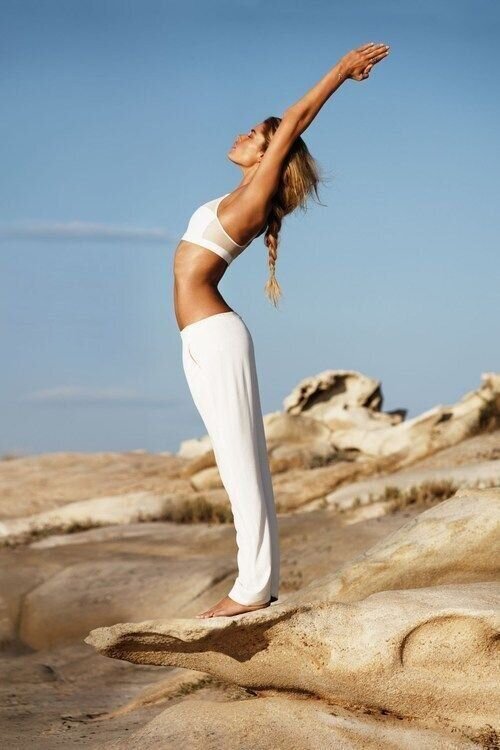Being flexible is more than looking good in your sports luxe outfit. It has brilliant health benefits, including preventing injury. It improves your posture, lengthens your muscles for a more extended leaner look, improves balance, and helps you feel calm and confident. According to naturopath Jane Cronin, it can also invigorate your spirit. Here's how to boost your flexibility and balance, resulting in great joint health.
Image Instagram
Boosting your flexibility not only helps keep your joints healthy, but it also enables the range of movement that gives your body strength and balance. According to naturopath Jane Cronin from Clinicians, “Whether you are exercising or playing sports, performing simple daily activities, such as climbing stairs, picking up a ball for the dog or crouching on the ground to play with the kids. Good flexibility and balance will give you the freedom to live the life you want.” More and more our lives have become sedentary or desk-bound, spending long periods sitting can stiffen muscles, making them inflexible, and uncomfortable. “As time goes on, we develop body movements and posture habits that can lead to reduced mobility of joints. Even being on your feet all day can affect joint health,” says Cronin who adds, “Moving and stretching as much as possible is essential. Staying active throughout your waking hours is particularly important for anyone living a sedentary lifestyle.” Cronin suggests, investing in a standing desk (if you’re office-bound), committing to a brief walk every hour for five to 10 mins during your working day. Stretching after exercise, while you cool down is also a must. “This can help reduce muscle fatigue, release tension and prevent potential post-workout muscle and joint soreness.” Cronin favours yoga or Tai Ch, to help lengthen your muscles, increasing your range of motion and flexibility, while boosting your physical strength and increasing balance. She adds, “Another benefit is that both these practices teach us to slow down and de-stress.”
How to boost your flexibility with balance
Even if you exercise regularly, you can still suffer from tension and stiffness, in the hamstrings, ankles, hips and shoulders, where stretching is key to keeping agile. After exercising is the best time to test your balance skills. According to Cronin, this is the best time to determine your physical strengths and weaknesses. Below are two relatively simple tests to assess your joint flexibility and balance. Ensure you take the test after a warmup or in the afternoon – avoid doing this first thing in the morning.
The 30-Second Balance Test
Find someone to time this test, as you will need to keep your eyes closed. Follow these instructions below.
Stand barefoot on a hard floor (avoid standing on carpet or rugs).
Close your eyes and bend one knee and lift your foot. If you’re right-handed, stand on your right foot and lift your left foot (and vice versa if you are left-handed) about 15 cms from the floor.
Write down the length of time it takes for you to keep your foot off the floor without wobbling or opening your eyes.
Repeat the test three times and then add up your total time and divide it by three to find your average balance base. (For example, if test one was 10 seconds, test two was 14 seconds and test three was 12 seconds it would be: 10+14+12=36 divided by three = 12 seconds).
The Sitting-Rising test
Developed by a Brazilian doctor (originally to predict mortality risk in middle-aged and older people), this test is a useful indicator for all ages to test joint flexibility, strength and balance. Follow these instructions below.
Stand barefoot and try to sit on the floor with your legs crossed with as little support as possible from your hands, legs, arms or other body parts.
From the seated position, try to stand up again with as little support as possible.
Give yourself five points if you sat with no support and five points if you got up without support. Each support required (such as a hand on knee or hand or knee on the floor) subtract one point. Subtract half a point if you were wobbly both sitting and standing.
Do the test twice and combine your best scores.
Your score can be used as a guide for improvement as you start to work on your flexibility. Find out your balance based age click here.
Nutrition
Finally, Cronin recommends a diet high in essential fatty acids, vitamin C and E as antioxidants, calcium and vitamin D help support bone strength. In contrast, magnesium helps with muscle movement and relaxation.
Clinicians MobiJoint Vegetable Capsules 30’s, $33.
Made with a unique and synergistic combination of BiovaFlex™ and Cat’s Claw, which provide all the building blocks to support healthy joint function and the body’s natural healing ability. BiovaFlex™ is a patented water-soluble egg membrane with research to support joint mobility and comfort in only 10 days.
Directions: This one-a-day formula is suitable alongside medications and long-term use.
For the month of February, purchase Clinicians MobiJoint Vegetable Caps 30’s or Clinicians Liposomal Turmeric 180mL from Unichem or Life Pharmacies and you will receive a FREE pack of MobiJoint Vegetable Caps 30’s worth $39.99.
Clinicians MobiJoint Vegetable Capsules 30’s, $33.
Supplements to support joint comfort & flexibility & bone strength
Clinicians Sunshine Vitamin D3 With Vitamin K2, $17. Clinicians Joint & Muscle Ease Spray, $18. Clinicians Liposomal Turmeric Liquid, $50. Clinicians Bone Care Complete, $40.






